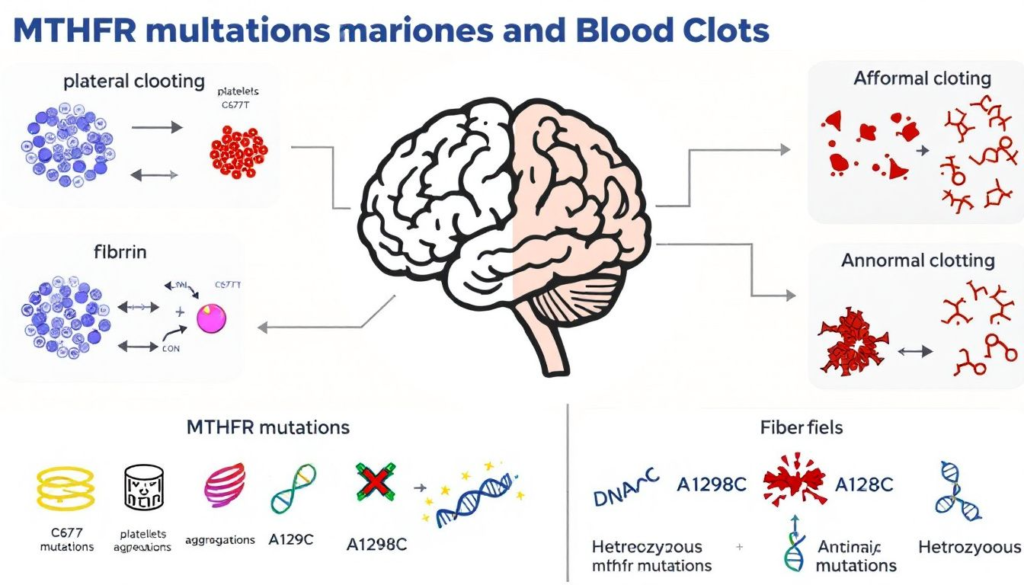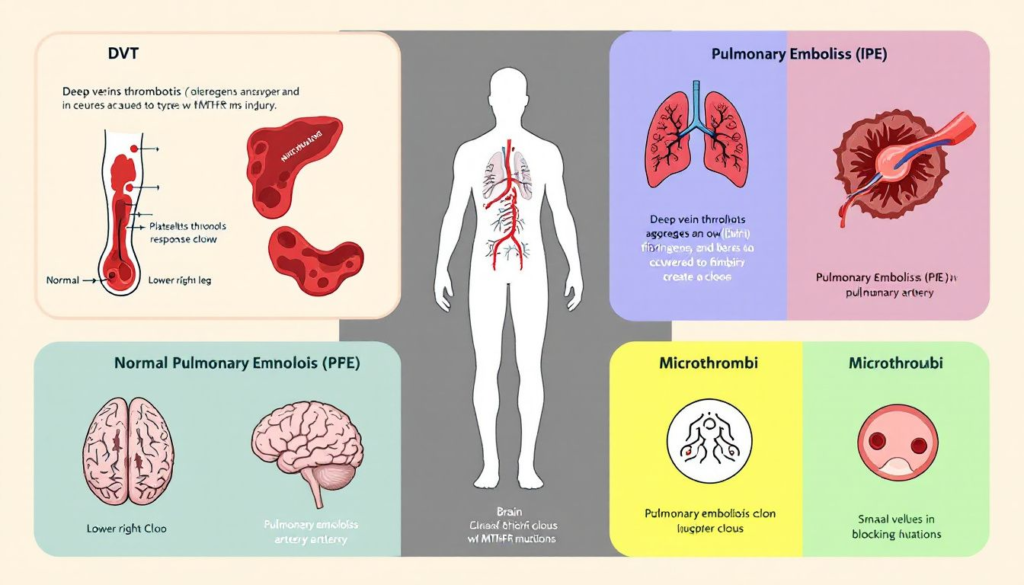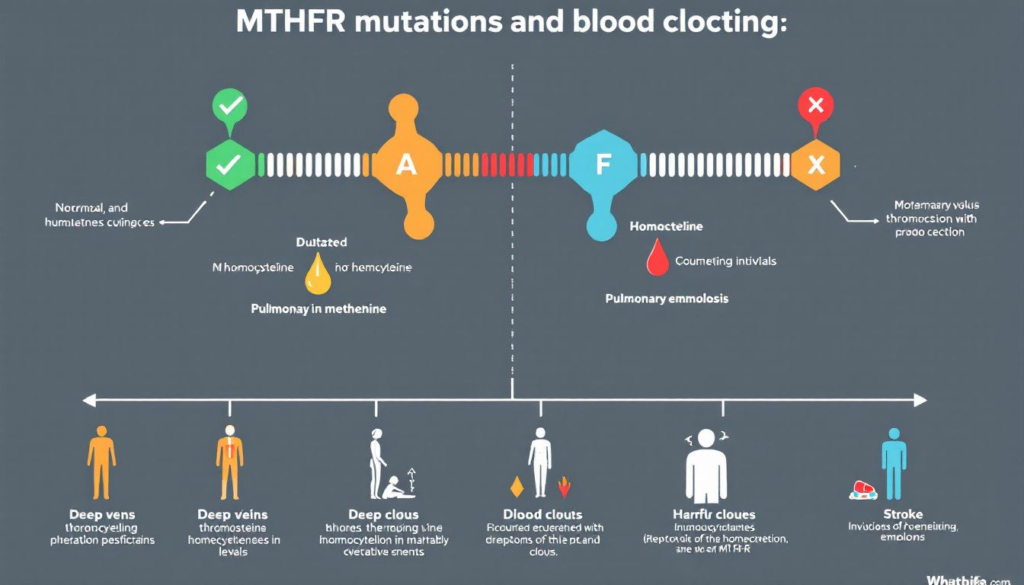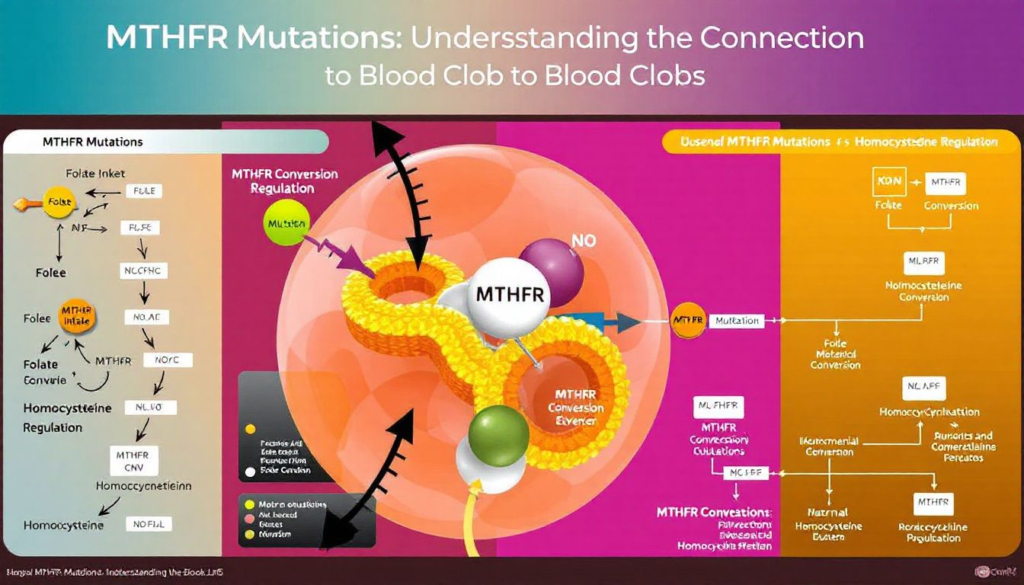Curious about how MTHFR mutations might affect your risk of blood clots? MTHFR gene mutations can lead to elevated homocysteine levels, increasing the risk of dangerous clots. This article explains the connection between MTHFR and blood clots, covers the symptoms to watch for, discusses types of clots involved, and outlines diagnosis and treatment options to manage these risks.
Key Takeaways
MTHFR gene mutations can lead to elevated homocysteine levels, increasing the risk of cardiovascular diseases and blood clots.
Symptoms of thrombosis in individuals with MTHFR mutations include deep vein thrombosis and pulmonary embolism, highlighting the need for vigilance and early detection.
Comprehensive management of MTHFR-related blood clots involves genetic testing, monitoring homocysteine levels, and lifestyle modifications, alongside medical interventions.
Understanding MTHFR Gene Mutations
The MTHFR gene, short for methylenetetrahydrofolate reductase mthfr, encodes an enzyme crucial for processing homocysteine into methionine, an essential amino acid for numerous bodily functions, including the synthesis of amino acids. However, mutations in the mthfr genes, such as the common ones C677T and A1298C, can significantly impair its function. The C677T mutation, for instance, results in a less active MTHFR enzyme, leading to elevated homocysteine levels in the blood.
Individuals with MTHFR gene mutations often experience higher levels of homocysteine, which has been linked to various health issues, including cardiovascular diseases and blood clots. Understanding these mutations and their effects, particularly the mthfr gene mutation, is the first step in mitigating their impact.
Testing for MTHFR mutations is essential for evaluating the risk of elevated homocysteine levels and related health issues. Identifying these genetic changes allows healthcare professionals to offer personalized recommendations to manage and mitigate the risks, empowering individuals to make informed health decisions and take proactive measures.
How MTHFR Mutations Affect Blood Clotting

MTHFR mutations can set off a chain reaction that significantly impacts our blood’s clotting ability. When the MTHFR enzyme is not functioning correctly due to these mutations, homocysteine levels in the bloodstream can rise. Elevated homocysteine levels are not merely a biochemical anomaly; they can have serious health consequences.
Increased homocysteine levels can damage the lining of blood vessels, making them more susceptible to irritation and injury. This vascular damage creates a conducive environment for blood clots to form. Individuals with MTHFR mutations and elevated homocysteine levels face a heightened risk of developing clots, which can complicate existing vascular health issues.
Although MTHFR mutations are not classified as a blood clotting disorder, the related elevated homocysteine levels significantly heighten the risk of clot formation. Understanding and managing MTHFR mutations is essential to reduce thrombotic risks, highlighting the complex relationship between genetic mutations and biochemical abnormalities.
Types of Blood Clots Linked to MTHFR Mutations

The types of blood clots associated with MTHFR mutations are varied and can have serious health implications. One of the most common types is deep vein thrombosis (DVT), which typically forms in the legs. DVT can be particularly dangerous because if a clot dislodges, it can travel to the lungs, leading to a pulmonary embolism (PE).
Pulmonary embolism is a life-threatening condition marked by symptoms such as difficulty breathing, chest pain, rapid heartbeat, and coughing up blood. Blood clots linked to MTHFR mutations often form in the extremities but can also occur in less common areas like the superior mesenteric vein and the portal vein. Recognizing these risks and symptoms is crucial for timely medical intervention.
Symptoms of Blood Clots in MTHFR Mutation Carriers

Individuals with MTHFR mutations must remain vigilant about blood clot symptoms. Deep vein thrombosis (DVT) often manifests as limb pain or tenderness, swelling, and skin color changes. These symptoms, though subtle, should not be ignored as untreated DVT can lead to severe complications.
A dislodged DVT can result in a pulmonary embolism (PE), characterized by difficulty breathing, chest pain, rapid heartbeat, and sometimes, coughing up blood. Awareness of these symptoms is critical for individuals with MTHFR mutations, as early detection and treatment can prevent life-threatening outcomes related to venous thromboembolism.
Diagnosing MTHFR Mutations and Blood Clots
Diagnosing MTHFR mutations and related blood clots involves a multi-faceted approach. Hyperhomocysteinemia, or elevated homocysteine levels, is a significant risk factor for thrombosis. Identifying the underlying cause of high homocysteine levels, whether through genetic testing or assessing vitamin deficiencies, is crucial.
MTHFR mutation testing is particularly important when there is a personal or family history of cardiovascular disease or thrombosis. By understanding one’s genetic makeup, including mthfr polymorphism, mthfr variant, and the associated risks, individuals can take informed steps to manage their health effectively.
The following subsections will delve deeper into the specifics of genetic testing, homocysteine level testing, and the role of family history.
Genetic Testing for MTHFR Mutations
Genetic testing for MTHFR mutations typically involves a simple blood test. This test can identify specific mutations in the MTHFR gene, such as C677T and A1298C, which are linked to elevated homocysteine levels and increased thrombotic risk. However, understanding the implications of these results requires professional medical guidance, including mthfr polymorphism testing.
Interpreting MTHFR testing results and understanding potential health risks necessitates consulting a healthcare provider. A doctor can offer personalized recommendations based on your genetic profile, enabling proactive steps to manage health and reduce blood clot risks.
Homocysteine Level Testing
Testing homocysteine levels is a vital component of assessing thrombotic risk in individuals with suspected MTHFR mutations. The average plasma homocysteine levels can vary significantly based on genotype, with individuals carrying the TT genotype having the highest levels.
This testing is critical because hyperhomocysteinemia, or elevated homocysteine levels, can be influenced by factors such as vitamin deficiencies. By measuring homocysteine levels, healthcare providers can better understand the underlying causes and develop targeted treatment plans to manage the associated risks.
Role of Family History
A family history of blood clots can be a significant indicator for evaluating the risk related to MTHFR mutations. If there is a history of early cardiovascular disease or thrombosis in your family, it is crucial to consider genetic testing and homocysteine level assessments.
Understanding your family’s medical history can provide valuable insights into your own health risks and guide preventive measures.
Treatment Options for MTHFR-Related Blood Clots

Managing blood clots related to MTHFR mutations requires a comprehensive approach. Treatment options may include lifestyle changes, dietary adjustments, and specific medical interventions. By addressing the underlying causes and risk factors, individuals can effectively manage their condition and reduce the risk of thrombotic events.
Healthcare providers play a crucial role in guiding treatment decisions and providing personalized recommendations. The following subsections will explore the importance of folic acid supplements and diet, medical interventions, and lifestyle modifications in managing MTHFR-related blood clots.
Folic Acid Supplements and Diet
Folic acid supplements and a folate-rich diet are crucial for managing elevated homocysteine levels in individuals with MTHFR mutations. Supplements and multivitamins with folate may be recommended to support homocysteine metabolism and amino acid homocysteine.
Discussing dietary adjustments and supplement use with healthcare providers ensures safety and effectiveness. A balanced diet rich in B vitamins, especially folate, can help mitigate risks linked to MTHFR mutations.
Medical Interventions
Healthcare professionals play a key role in managing blood clots linked to MTHFR mutations. They evaluate the impact of these mutations on an individual’s clotting risk and recommend appropriate treatments, which might include anticoagulants or other medications.
Consulting healthcare professionals ensures that individuals receive personalized and effective treatment plans.
Lifestyle Modifications
A healthy lifestyle is vital for individuals with MTHFR mutations to reduce blood clot risks. Here are some key components to consider:
Maintain a diet rich in folate, vitamins B6, and B12 to support healthy homocysteine levels.
Engage in regular physical activity.
Avoid smoking.
Stay hydrated.
These practices can significantly lower thrombotic risks.
Weight management is also important, as maintaining a healthy weight can help minimize the risk of developing blood clots. By combining these lifestyle modifications, individuals with MTHFR mutations can effectively manage their health and reduce the risk of thrombotic events.
Other Genetic Factors Influencing Blood Clot Risk
While MTHFR mutations are a significant candidate genetic risk factor in blood clot risks, they are not the only genetic contributors. Other gene mutations, such as F2 and FVL, also play a role in increased risk of thrombotic risk.
The presence of both MTHFR mutations and other genetic factors like F2 and FVL can further elevate the risk of thrombosis. Understanding the interplay of these genetic factors, including mthfr variants and mthfr polymorphisms, is crucial for a comprehensive risk assessment and effective management of blood clot risks.
Consulting Healthcare Professionals
Seeking professional medical guidance is essential for individuals with MTHFR mutations. Healthcare professionals can provide personalized assessments and tailored treatment plans to manage the risks associated with these genetic mutations.
Proactive consultation with healthcare providers ensures better management of MTHFR-related clotting disorders and overall health.
Summary
In summary, understanding MTHFR gene mutations and their impact on blood clotting is crucial for managing associated health risks. Elevated homocysteine levels due to MTHFR mutations can lead to serious complications, including deep vein thrombosis and pulmonary embolism. Recognizing the symptoms, undergoing appropriate testing, and consulting healthcare professionals are vital steps in managing these risks.
By adopting a comprehensive approach that includes dietary adjustments, medical interventions, and lifestyle modifications, individuals with MTHFR mutations can significantly reduce their thrombotic risk. Armed with knowledge and proactive measures, we can take control of our health and prevent life-threatening complications.
Frequently Asked Questions
What are the symptoms of severe MTHFR?
Severe MTHFR gene mutations can manifest as chronic inflammation, chronic fatigue, dizziness, hives, and heightened allergic reactions, among other symptoms. It is imperative to consult a healthcare professional if you experience these signs.
Can high homocysteine levels cause blood clots?
High homocysteine levels can increase the risk of blood clots by damaging the artery lining and promoting excessive clotting. Therefore, managing homocysteine levels is crucial for vascular health.
Can MTHFR cause blood clots?
Yes, MTHFR mutations can contribute to blood clots, particularly in individuals with elevated homocysteine levels, which may irritate blood vessels. However, those with normal homocysteine levels do not face an increased risk.
What is the MTHFR gene and why is it important?
The MTHFR gene is crucial as it encodes an enzyme that converts homocysteine into methionine; mutations can elevate homocysteine levels, raising the risk of blood clots and associated health complications. Understanding the function of this gene is essential for evaluating cardiovascular health risks.
How do MTHFR mutations affect blood clotting?
MTHFR mutations can significantly increase the risk of blood clotting due to elevated homocysteine levels, which damage blood vessels and can lead to serious conditions like deep vein thrombosis (DVT) and pulmonary embolism (PE).

